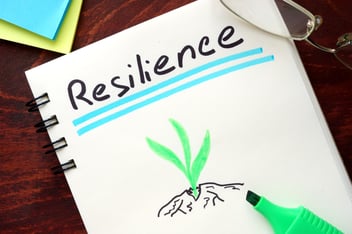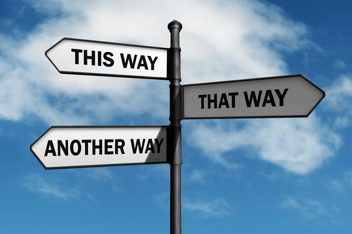
Is collaboration dressed up as consensus in your organization? Is it making your efforts at collaboration a bit scary? Are you spooked when it comes to decision-making? Using these tricks will make collaboration a treat.
Written by Janice Francisco
Is collaboration dressed up as consensus in your organization?
Many organizations strike committees to tackle business challenges or to support innovation.
In general, this is a good idea. It sets up opportunities for cross-functional collaboration, offering diverse viewpoints and support to achieve a goal.
But one of the challenges I see with this approach repeatedly is that these committees form without much thought about how they'll work together. They don't have a process for problem-solving, and members don't have clarity on who owns the problem and who holds decision-making authority. Nor do they know how they'll make decisions.
So, the group forms, they get down to work, and when it comes to advancing ideas or making decisions, they get stalled, tricked out, and generally frustrated with the process.
The worst part of this?
These groups often think they need consensus from all committee members on what they're doing and how they'll do it; it's a highly unproductive way to work.
And, it's downright scary.
So, what can you do if you find yourself in a situation where collaboration dresses up as consensus?
Collaboration vs consensus
First, let's not conflate consensus and collaboration; let's not assume that you need consensus when collaborating.
Collaboration is a process of producing or creating something with others. You do it by clarifying the associated challenges, generating and exploring ideas, developing solutions, and working on getting them implemented. Collaboration isn't about getting everyone to agree. It's about leveraging a diversity of viewpoints and getting the right people, at the right time, appropriately involved in a thinking process focused on producing results.
Consensus, on the other hand, is limited to a specific form of decision-making. It's about having unanimity and agreement around an issue or solution that impacts everyone in a group.
So, is it consensus or collaboration that you need?

The truth is that very few situations require consensus, and many need collaboration.

Collaboration is best suited to complex challenges - you know the ones - they're multi-faceted, often ambiguous situations that can impact many people and have uncertain outcomes. There's no prescribed approach to resolving them; they rely on figuring it out as you go. These kinds of challenges need multiple skill sets or teams to resolve. And, when stakeholder buy-in, participation and engagement are at the heart of creating the commitment necessary to drive change or gain acceptance for innovation, you need to collaborate. In this case, we don't need everyone involved to agree on the same solution, decision, or conclusion, but we do need their agreement to work towards a shared goal and contribute their thinking to achieve it.

Now, if you find yourself in a situation where a decision does need unanimous agreement, you'll still need to collaborate until you reach a consensus. In this case, you must make it clear from the start that consensus is required and that you'll need to allocate time to go through the thinking process that will allow that to happen.
How to make collaboration a treat
First, recognize that collaboration is a team sport. And like any sport, there are rules to follow, everyone has a specific role, and there is a shared process that guides play. Otherwise, nobody wins.
Here are three tricks to ensure you're not involved in a scary collaboration.
- Know your process
- Eliminate role confusion
- Follow the rules
Know your process
What's your process for collaboration?
Have you ever noticed that everyone brings a different vision of what that looks like to the table?
We make assumptions about how we'll work together and then wonder why we end up in conflict or feeling stuck or unproductive.
The best process I've found to guide collaboration is creative problem-solving.
Why?
Because the primary function of teams (or committees, for that matter) is to solve problems to advance an organization's goals, it makes sense to give them a shared process for problem-solving.

Creative problem-solving is particularly good for solving complex problems – precisely the problems you need committees to tackle and that require collaboration. Initially developed 65 years ago, it's the most researched problem-solving model in the world – we've used it with clients and taught it to them for over 15 years, and it's worked every time.
Eliminate Role Confusion
Have you ever been confused about who's doing what and when in your efforts at collaboration? Or have you found yourself stuck or left with everyone pointing fingers at each other when it comes to decision-making?
Think about what happens on an average sports team. In any given season, while the players may change positions, the owner and coach are typically in place to guide the play process. The same happens when you use creative problem-solving as your structure for collaboration.
Collaborative problem-solving is a necessary part of business whether you're engaged in operational work, driving change or promoting innovation; it's one of the significant plays. Many players, also known as stakeholders, must be involved at various stages. And while these players may come and go as the problem-solving process unfolds, the one constant in this process is the player who owns the problem.
And therein lies the secret to decision-making. Problem-solving needs collaboration, not decisions by committee or consensus.
Many of the leaders and teams I work with overly confuse collaboration. Concerned about engaging people in innovation, change or operational problem-solving, they overlook the importance of clarifying roles and responsibilities in that process. And this has a significant impact on being able to keep moving forward.
In reality, all collaborators are not equal.
When you use creative problem-solving as your structure for collaboration, you have a proven approach to eliminate role confusion.
Here's why. In creative problem-solving, there are three primary roles people play. And when you know these roles and how to use them, you can end the role confusion that often sidetracks collaborative work.
When you integrate these three roles and clarify each role, everyone knows what to do, and the scariness surrounding decision-making vanishes.

Here are the roles, with a brief description of each below.
- Client - the person responsible and accountable for the team's work. This is the person who holds decision-making authority in the meeting.
- Resource Group - the people invited to participate and contribute thinking. These people can inform decisions, but don't make them.
- Facilitator - the person responsible for leading the group through the meeting process.
Here's what I like about these roles. They're simple. There's clarity around who gets to make decisions (the Client), who contributes thinking (the Resource Group and Client), and who supports the creative problem-solving and engagement process (the Process Facilitator). And the roles are explicit and transparent. Even if a Client or Resource Group member needs to take on the role of Process Facilitator in the group, the objective is to maintain clarity on what position you're playing at every step.
Follow the rules
With creative problem-solving as your process, one of the rules is to use separate and distinct modes of thinking - divergent and convergent thinking. Most people don't know how to do this, which muddles collaboration and consensus.
Here's how it works:
First, you approach a challenge or opportunity using divergent thinking, characterized as an unconstrained broad search for many diverse and novel alternatives.
Then, once sufficient options are on the table, the process switches to convergent thinking used to screen, select, prioritize, organize and refine options. Convergent thinking is a focused, affirmative evaluation designed to improve and advance promising possibilities.
But herein lies the rub.
While the more viewpoints, the better when it comes to divergent thinking, less is more when convergent thinking. Not everyone gets to go to the table in both cases. Only the Client and select Resource Group members, with the help of the Process Facilitator, get to move through the convergent thinking step – otherwise, the results are scary.
Here's the trick
So, the next time you are involved in collaboration and struggling for a decision, call a time out and ask yourself, "Am I confusing collaboration with consensus?". And think about who needs to be at the table and what kind of thinking you need.
By ensuring the roles and responsibilities are well-defined ahead of time, collaboration needn't be such a scary experience!
Want to learn more?
Need help with your next meeting? Let's chat about it.
We promise it won't be scary, and you'll be in for a real treat!
I’ve long been a fan of the work of Tom Fishburne, the Marketoonist. He’s a cartoonist who combines his knowledge of brand marketing and innovation with his passion for drawing. If you’ve attended any of our courses, you’ll likely recognize that we’ve licensed many of his cartoons because they so eloquently capture the spirit of the challenges associated with building cultures of innovation. I trust you'll enjoy his creativity and perspective.
Click here to see Tom’s full cartoon and lesson on designing by committee.
-Nov-07-2022-09-25-54-1140-PM.png)

